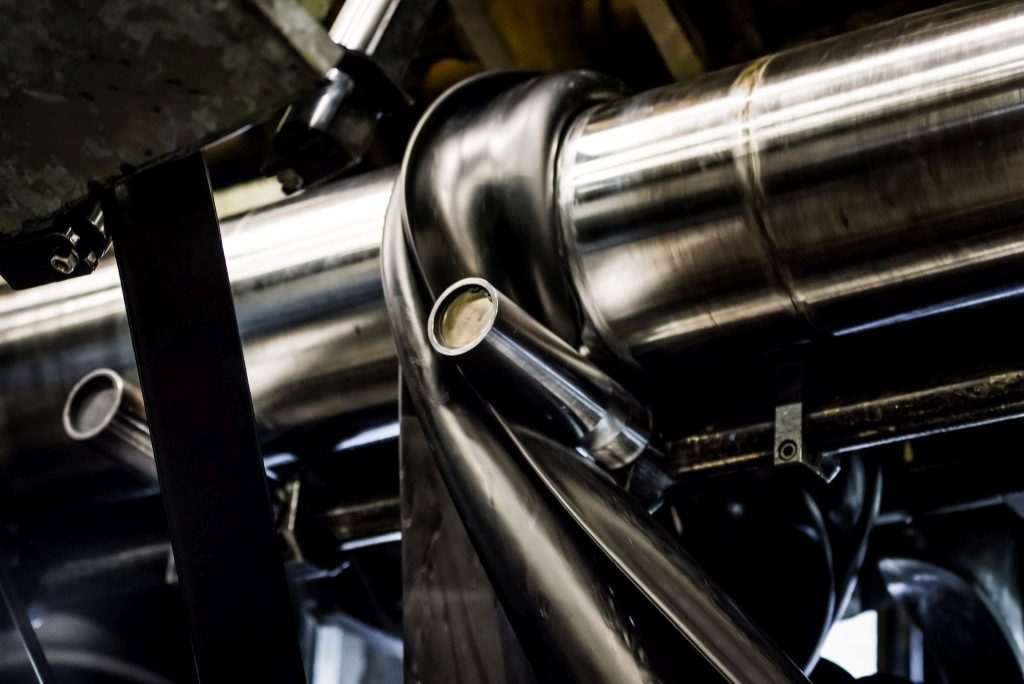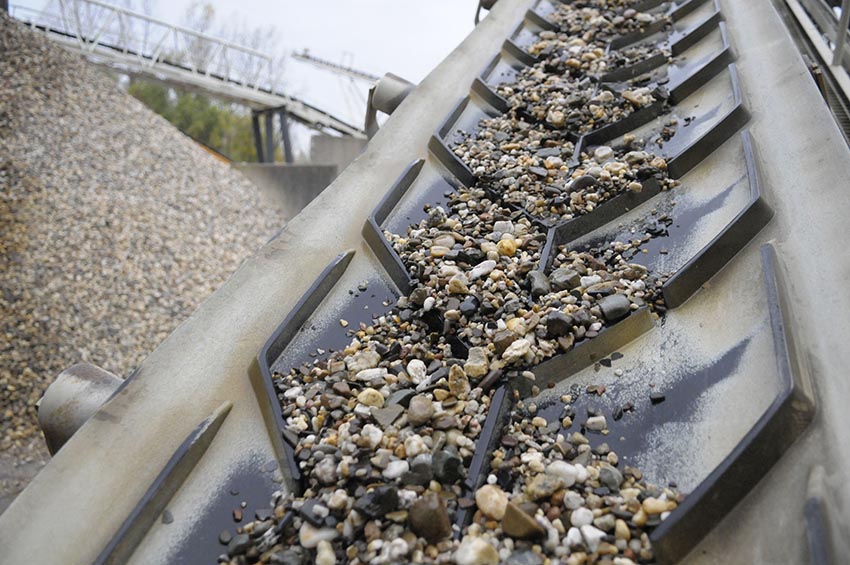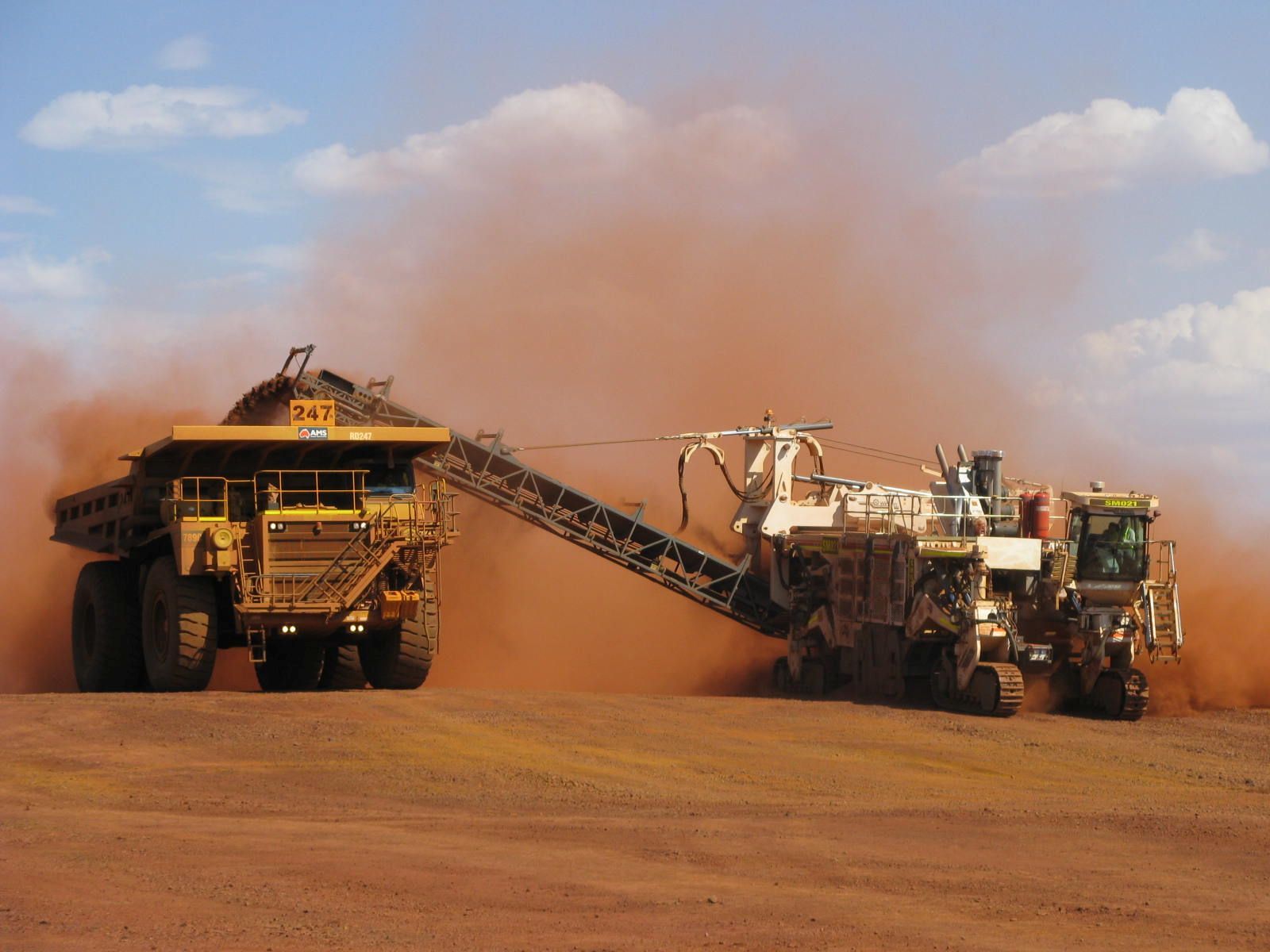Chevron profile conveyor belts are a key component on a huge variety of conveyors that are used to transport materials up and down inclines and gradients in order to prevent the materials from slipping. This is especially so in locations where space is at a premium. Despite the important function they fulfil, relatively little is known about them technically. As a consequence, even less is understood as to why some chevron belts are so much more efficient and less troublesome than others. Here, conveyor belt specialist Leslie David explains the different production methods, how they ultimately affect reliability and how to avoid literally being ripped off.
Getting to grips
Excluding belts that have cleats fitted to them, there are essentially two types of profiled rubber conveyor belt. The most commonly used are those with chevron-patterned profiles ranging from 15mm up to 32mm in height above the belt surface. The chevrons guide and control the flow of loose materials such as sand or small size aggregates for example. The second most common type are belts with low profiles that are usually no more than 5mm.
One of the most common problems experienced by many operators affects high chevron belting because the chevron profiles can become partly detached or ripped off entirely.

With both high and low profile belts another common problem is that the profiles themselves wear down within an unacceptably short period of time. The origins of these problems are both to be found within the manufacturing processes and the rubber compounds that are used.
Conventionally produced chevron belting – The Achilles Heel
Because of its adaptability, most of the rubber used to make modern-day conveyor belting is synthetic. Because of the technical difficulties (and higher cost) involved in creating a synthetic rubber compound that will flow uniformly, the vast majority of chevron profile belts are effectively created using a two-stage vulcanisation process. Firstly, a belt carcass consisting of layers of fabric reinforcing ply and covered by a layer of uncured rubber compound on the top and bottom surfaces is placed in a vulcanisation press. At the same time, a mould plate is filled with uncured rubber and the base structure is then placed on top of the filled mould. Alternatively, the mould plate is extracted, filled with uncured rubber and then replaced back under the base structure. In both cases, the complete structure is then vulcanised to create the finished belt.
The key issue here is that the uncured rubber compound used to construct the base belt structure cannot be the same as the compound used to fill the moulds. This is because the rubber used in the moulds to create the actual chevron profiles has to be more malleable than the rubber used on the top and bottom cover surfaces so that it can completely fill the mould cavity.
However, this directly creates the ‘Achilles heel’ of all chevron belts made in this way. This is because the contact point where the two different rubber compounds join then becomes a point of weakness. The chevron profiles constantly stretch and flex under tension each time they run around a pulley or drum.

Unless the bond between the base belt carcass and the chevron profile is absolutely flawless then sooner or later dynamic stress fractures in the profile will start to occur, causing the profile to split. Especially on belts conveying hard, heavy lumps of material, the constant impact weakens the joint between the base belt and the chevron. Either way, eventually the chevron will part company with the rest of the belt.
The problem is significantly magnified on conveyors with relatively small pulley diameters, especially mobile equipment. The smaller the pulley then the higher the dynamic stress. Failure will happen even sooner if one (or both) of the rubber compounds used are not fully resistant (as per ISO 1431 testing) to the effects of degradation
Rapid wear
Having to use a rubber that is sufficiently malleable (pliable) so that it will fill the mould cavities and accept the dynamical strains of belt operation often creates a second major ‘belt life-threatening’ weakness.
Research and experience has shown that the rubber used to make the chevrons in the conventional two-step production process almost invariably has much lower resistance to abrasive wear than would normally be acceptable. It is not unusual, especially among so-called ‘economy’ belts imported from Asia, that even chevrons as high as 25mm or 32mm can wear almost completely flat in a remarkably short time.

Make it once, make it strong
The fact of the matter is that there is only one way to avoid the inherent weaknesses created by the conventional manufacturing methods that I have just described. Firstly it requires the use of a single rubber compound that has been specially engineered for both the base belt structure AND the chevrons. Secondly, it is essential that the belt is produced as a single, wholly homogenous structure. This can only be achieved using a one-step production process rather than the more conventional two-step process. In other words, making the belt once makes it considerably stronger. The inescapable truth is that a homogenous structure, even if damaged or split, is simply much stronger and more resilient against spreading damage or having profiles shear off completely when two non-identical materials (compounds) are bonded together.
That may sound straightforward to achieve but it is a surprisingly tall order. Firstly, it is extremely difficult (and more costly) to create such a versatile rubber compound. This is largely due to the huge number of different chemicals, polymers and additives that are used to create the synthetic rubber. All of the various components have to be very precisely balanced and mixed so that the final compound possesses all the necessary physical properties.

These properties include wear resistance, tensile strength and durability while at the same time also being sufficiently malleable to allow the rubber to flow smoothly and evenly into the moulds. The rubber then needs to be able to vulcanise virtually simultaneously within the mould AND the base belt structure. Not only that, the compound also needs to be fully resistant to the effects of ozone and ultra violet light (for longevity of working life) and conform to European REACH regulations so that the end product is also safe to handle.
‘Single homogenous structure‘ chevron belting – How do they do it?
To create a single homogenous structure the base belt (at this stage comprising of only uncured rubber) is placed in the vulcanising press between the base plate of the press and a chevron mould plate positioned immediately below it. The base belt will already also have a specific quantity of uncured rubber on the top cover surface in addition to the volume of rubber needed to achieve the minimum thickness of the top cover of the base belt once it has been vulcanised. The actual amount of ‘extra’ rubber needed depends on the design and depth of the chevron pattern. The compression of the upper and lower plates then forces the additional rubber to flow into and fill the mould cavities. Vulcanisation of both the base belt structure and the rubber-filled moulds then takes place simultaneously to form a single homogenous unit.

Bearing in mind the technical complexity and the higher costs involved, perhaps it is not surprising that apart from Dunlop Conveyor Belting, hardly any other manufacturer of note produces profiled chevron belt in this way. However, the significantly superior strength, reliability and much longer working life that is created by chevron belting being made in this way makes it not only worth the effort but also worth the investment.
How will I know?
Even when armed with this understanding of the huge difference in strength and overall durability between chevron belts made using the conventional ‘two-step’ process and the ‘single homogenous structure‘, the dilemma then is how to establish which kind is being offered by the manufacturer/supplier who is providing the quotation. Unfortunately, the only way to find out is to ask the would-be supplier and then hope that the salesperson you are speaking to actually does know the difference!

Keeping a low profile
‘High’ profile chevron belts are available in a variety of different heights, mostly 16mm, 25mm and 32mm. Some manufacturers only make the 25mm version. However, there are several belts on the market that have profile patterns that are little more than 5mm high and sometimes even less. Belting of this kind is mostly used for the transportation of packaged goods such as boxes, bags and baggage as well as bulk materials including agricultural products, oily materials, woodchips and wet sand and can successfully be used on inclines as steep as 30° in some cases.
Unlike their chevron counterparts, making single, homogenous structures is relatively easy to achieve with low profiles because the rubber only has to flow a small amount compared to high chevron profiles. Yet again, the key influencer as far as performance and value is concerned is the quality of the rubber. In this case it is ability of the rubber to resist wear (abrasion) and to resist the effects of ozone & ultra violet that are the most crucial. As far as European-based quality led manufacturers like Dunlop are concerned, achieving working lifetimes as long as five years is more than possible.

Don’t be fooled
When it comes to profiled belting, appearances can be very deceptive. One belt may look virtually identical to another belt and the basic specifications such as tensile strength and number of plies may also be identical. Therefore, expecting that the actual performance and working lifetime will be roughly the same would seem to be a reasonable assumption. However, the alarm bells should start to ring if there is a significant difference in the asking price. Actually, there is a very good reason why one belt can have a dramatically lower price compared to one of a seemingly identical specification, and that reason is very easy to explain. Ultimately, the difference in price will come down to the quality of the rubber, and it is the quality of the rubber that will have the biggest bearing on performance and the cost-effectiveness of the end product.
The rubber used for conveyor belts usually constitutes at least 70% of the material mass and therefore it is the single biggest element of cost when manufacturing a conveyor belt. Consequently, in the highly price-competitive conveyor belt market, for those who want to compete for orders based on price rather than performance and operational longevity, it becomes the single biggest opportunity for manufacturers to minimise costs. In fairness, the market for OEM’s of mobile plant equipment is also very competitive. This often means that any desire to pay a higher price for a higher quality, more durable conveyor belt is set aside in the effort to keep the selling price of their machines as competitive as possible.

The harsh reality is that conveyor belts used on mobile equipment are viewed by a great many as readily disposable components that are not a reflection of the reliability of the machine itself, even though the need to regular repair and replace worn and damaged belts is expensive both in terms of lost productivity and day-to-day running costs. A cynic might also say that for some manufacturers, belt suppliers and engineers, regularly replacing belts is a highly lucrative business that would not be nearly so profitable if the belts were a lot more durable and lasted a lot longer. Fortunately, for the higher-quality belt manufacturers, not everyone thinks that way.

The slippery slope
The two most common methods used to keep rubber costs to an absolute minimum are the use of recycled rubber (usually of highly questionable origin) and the use of cheap ‘bulking’ fillers such as chalk to replace part of the rubber polymers in the rubber compound. Another practice is the burning of used rubber car tyres to create a cheap form of carbon black. Some 20% of rubber compound is made up of carbon black so it has a notable impact on the overall cost of making a conveyor belt. Good quality carbon black is created by a process of burning oil in a strictly controlled, low oxygen environment so that combustion is incomplete. But burning used car tyres not only pollutes the atmosphere it also means that any oils and greases contained within ‘regenerated’ materials compared to good quality carbon black will have a detrimental effect on the physical properties of the rubber.
Key messages
Making profiled belts that do what they need to do and, arguably most importantly of all, give the best return on investment by providing the longest possible working life, is something very few belt manufacturers can achieve. Fortunately, although they are a very rare breed indeed, there are at least one or two still out there that continue to prove that chevron belts that are genuinely durable and last much longer than the ‘cheap’ imitations cost appreciably less and are much less hassle in the long run.
Article by Leslie David

